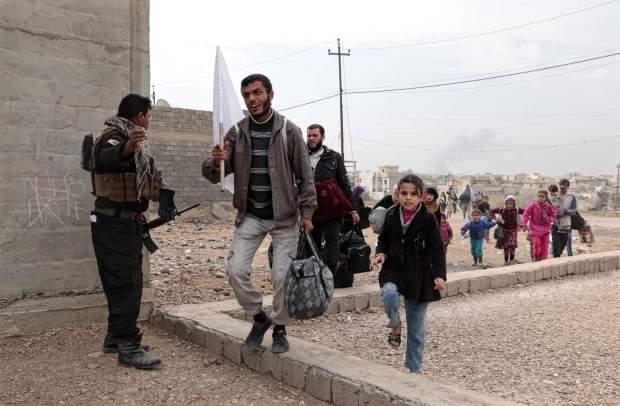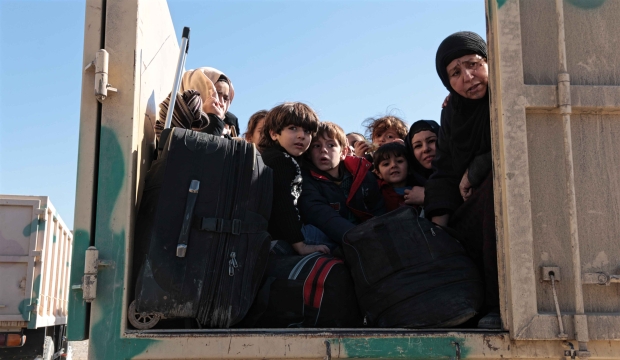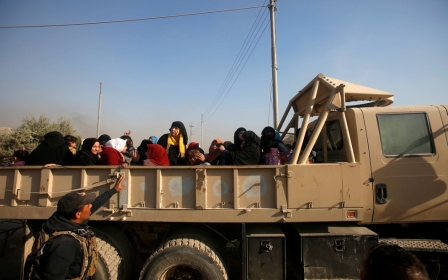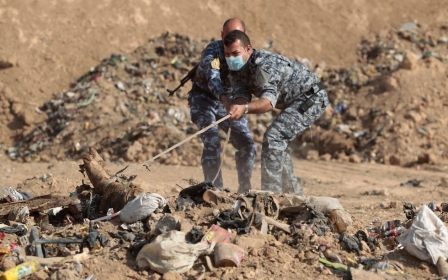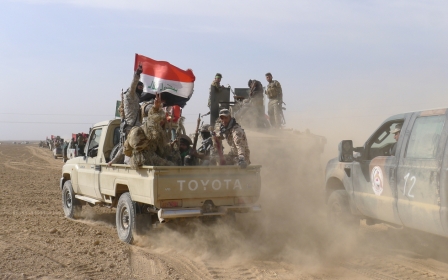Battle for Mosul: How IS is making life tough for Iraq’s elite forces
MOSUL, Iraq - Jassem Mohammed is a diminutive man who always carries his M4 assault rifle by his side. Clad in black - the trademark colour of his elite unit - he proudly wears a strap loosely around his hips. It is used to attach himself to a helicopter during airborne missions, but is also an item of pride carried by the counter-terrorism troops battling Islamic State (IS) in Mosul.
The Iraqi Special Operations Forces (ISOF), more commonly known as the Golden Division, have fought inside Iraq's second-biggest city since 1 November. It is a gruelling, nasty fight: The militants are a resilient and reckless foe, hiding among the population to launch suicide cars and mortar shells.
But the Golden Division is not immune to the intensity of the conflict. While commanders refuse to discuss casualties, a steady stream of Humvees deliver dead and wounded to a field hospital in the district of Gogjali, just outside Mosul, during periods of heavy fighting.
Driving at full tilt over the dirt tracks that connect Gogjali to Mosul, the Humvees kick up huge clouds of the fine sand that defines the barren landscape around the city. At the hospital, dust-caked soldiers lift bodies draped in blankets from the back of the vehicles, or help wounded comrades alight.
READ: Battle of Mosul: Liberation, desperation, interrogation
One of these was Amjad Hamid, the gunner of the Humvee driven by Jassem. During combat in the Aden neighbourhood of Mosul, Amjad was badly wounded by a rocket-propelled grenade while he was manning the turret of the armoured car. After making it to Gogjali, he was transferred to a hospital in Erbil, where he remains in a critical condition.
"It bothers me," Jassem said simply, when asked about the fate of his friend and comrade, his eyes revealing his hurt.
'The suicide cars are the problem'
Three days later, Jassem was again advancing through the dense urban sprawl of eastern Mosul when a grenade bounced off the turret and dropped on to the engine hood. The explosion ripped through the radiator and set the engine block on fire. Jassem managed to race the lumbering Humvee back towards Iraqi lines before it cut out.
IS knows the weak points of the US-made fighting vehicles. It directs its fire at the radiators at the front and top of the bonnet
The battered vehicle is now in the hands of Omar Khaleel, a mechanic who has set up shop at the battalion's base in Gogjali. A burly man, who likes to slam a heavy truncheon on to the vehicles entrusted into his care ("If I run out of ammunition, I will use this to fight," he joked), Omar has been busy of late.
He was working on two Humvees that were disabled in the fighting. As the driver, Jassem stays at the base until his vehicle is battle-worthy once again: The rest of his crew are in the city, fighting on foot.
IS knows the weak points of the US-made fighting vehicles, and directs its fire at the radiators at the front and at the top of the bonnet. Omar has taken off the entire front section of the vehicle, removed the torn-through radiator, and is waiting for spare parts to arrive. It is the fourth Humvee from his battalion that he has had to patch up this week, he said. Some vehicles are so damaged that they have to be written off.
The ISOF were created with the help of US special forces to tackle the insurgency that plagued Iraq after the 2003 invasion. Specialising in raiding suspected militant hideouts, the elite soldiers feel well equipped for the urban combat of the Mosul battle. Still, they concede that they are struggling with IS's seemingly endless supply of mechanised suicide bombers.
READ: The crisis that will surely follow victory in Mosul
"This is the fight we were trained for. But we were not trained on how to deal with car bombs," said Amar. Captain Hamza, who rides in the same Humvee as Amar, agreed with his colleague.
"The suicide cars are the problem. A sniper or a machine gun can take out one man, but a suicide car can kill 20. When a column drives down a street, there are six street corners from which they could come," he said.
Why Iraqi forces want more bulldozers
In a forward base of their unit in the Mosul neighbourhood of Kirkukli, the soldiers are protected from suicide car bombers by earthen barricades that have been piled up to cut off the side roads that lead into a street. Here a cluster of black Humvees is parked in front of the house that serves as a command post.
At each end of the street, more Humvees have been parked to seal off the road. The combat bulldozers that remove obstacles and swiftly place barricades are becoming increasingly important - and increasingly scarce.
'I told myself: "If I shoot him, how can I justify this to God?"'
- Iraqi Special Forces captain
"The vehicles that we need most, and the vehicles that we lose the most, are bulldozers," said Hamza. The civilian construction vehicles, clad in steel and bulletproof glass and painted black, are part of any foray into enemy territory.
At the forward base in Kirkukli, the soldiers look on as men, women and children file past. Grouped in families, with the head carrying a white flag and the rest burdened with hastily packed bags, civilians constantly move around the areas just behind the frontlines.
Some seek to leave the city, but many only flee to areas where the threat of IS mortars fire and car bombs is reduced. Others simply stroll around their neighbourhood, trying to ignore the gunfire and the explosions going off around them.
As the government and the humanitarian sector have failed to prepare for a mass exodus of civilians out of the city, Baghdad has advised Mosul's inhabitants to stay put. Many civilians in liberated neighbourhoods have followed this advice. IS is preventing the population from leaving the areas under its control, which remain fully inhabited.
In previous battles, the Golden Division defeated IS in cities emptied of their populations. The civilian presence in Mosul leaves Iraqi forces hamstrung. IS sympathisers hide among the liberated population and are difficult to identify in the combat zone. The ISOF are wary of suicide bombers hiding among the locals, and suspect that spies keep IS well informed about their positions and movements.
Hamza told how he was scanning a fought-over area with the scope of his sniper rifle when he saw a man pace about a rooftop. The man was likely a militant spotter, but he was unarmed. Unsure of what to do, in the end the captain desisted from pulling the trigger.
"I told myself: 'If I shoot him, how can I justify this to God?'" he said.
Where Iraqi strategists got it wrong
The risk of killing civilians has reduced fire support to a minimum in the battle for Mosul, greatly slowing the advance.
"The problem was always the over reliance on airpower, which by the time Mosul had started had still not been overcome," said Michael Stephens, head of the Royal United Services Institute Qatar.
'It is really difficult to target ISIS in some of these areas without causing huge civilian casualties'
- Michael Stephens, Royal United Services Institute Qatar
"The Golden Division has little artillery to rely on and almost no air support. It is really difficult to target ISIS in some of these areas without causing huge civilian casualties. ISIS have no such qualms, and so what we have is an imbalance tactically."
The militant defenders are also helped by the fact that Iraqi forces have failed to mount a concerted attack on Mosul. As ISOF troops are advancing doggedly in the east of Mosul, the Ninth Armoured Division is slowly moving through the Intisar neighbourhood from the southeast. But the 16th Division has failed to breach Mosul from the north, and the 15th Division is still several kilometres from the city limits on the south side of the Tigris, which dissects the city.
Without its defences being stretched, IS is able to throw men and material at the Golden Division, which is paying the price for being Iraq's most effective force.
Senior ISOF commanders suggest they have fallen victim to poor planning, and politically motivated decision-making.
Prime Minister Haider Abadi was poorly advised when he signed off on the battle plan, said one colonel who spoke to MEE on condition of anonymity. One major flaw was that the route to Syria was not shut down quickly, and is only now being slowly cut by Shia militia units advancing in the town of Tal Afar near the border.
The prime minister also insisted that the elite outfit, which is under his direct command, push ahead regardless of the progress made by the rest of the military, according to the colonel.
READ: The liberation that awaits Mosul
"Abadi told the Golden Division to go into Mosul as soon as possible and to not stop advancing," he told MEE.
The lopsided advance into Mosul is not simply the result of strategic ineptness, but also reflects the inadequacy of the Iraqi army.
"The Golden Division has been relied upon too much, causing a disjointed approach to the offensive, but that is partly victim of circumstance rather than poor planning," said Stephens. "The resources at hand needed to complete the mission are as they are and you can't change that force mix."
If Iraqi forces were able to tighten the noose around Mosul effectively, the battle would soon be over, said Hamza.
"If we attacked Mosul from all sides, the city would fall in 15 days in the worst-case scenario.”
This article is available in French on Middle East Eye French edition.
New MEE newsletter: Jerusalem Dispatch
Sign up to get the latest insights and analysis on Israel-Palestine, alongside Turkey Unpacked and other MEE newsletters
Middle East Eye delivers independent and unrivalled coverage and analysis of the Middle East, North Africa and beyond. To learn more about republishing this content and the associated fees, please fill out this form. More about MEE can be found here.



